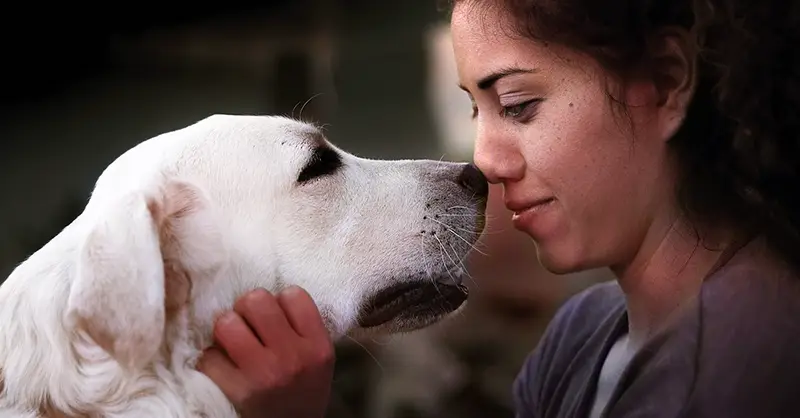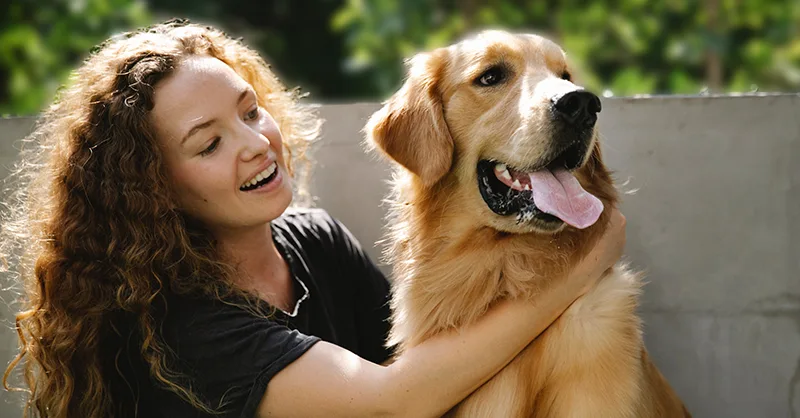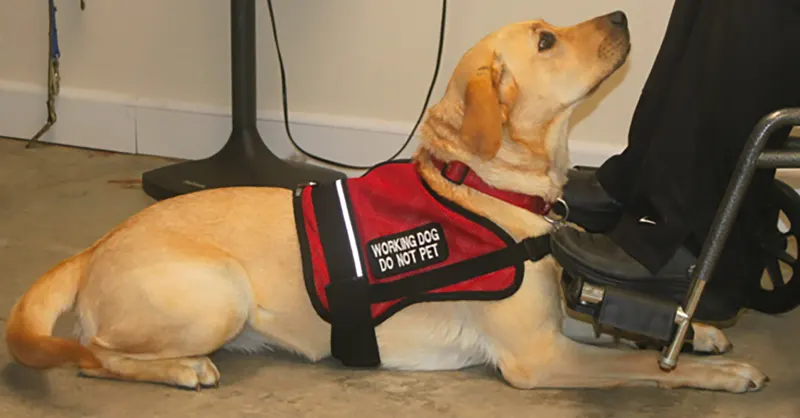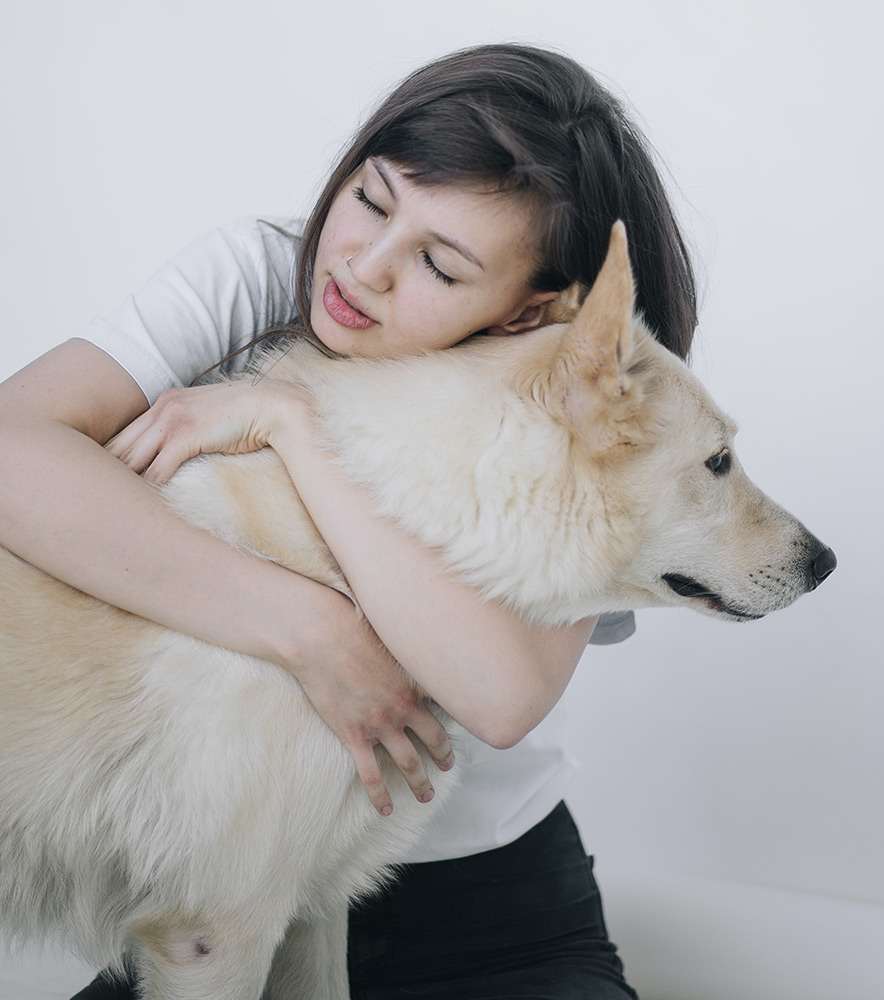Archive for the ‘Psychiatric Service Dog’ Category
Almost 40% of U.S. households own a dog, and an average of $253 is spent each year on veterinary costs to keep family dogs in good health. This love for dogs isn’t surprising because dogs have been intertwined with human life for the last 11 000 years. Dogs are human’s oldest companions, hunting alongside us and saving our lives for millennia. Today, dogs don’t serve as our hunting partners as much as they used to, but they still work to assist us in other ways. And among the most hard-working dogs are trained service dogs. Below we’ll list the five different types of service dogs that may be at your service.
What Are Service DogsAccording to the Americans with Disabilities Act (ADA), a service animal is a dog that receives special training to execute a task that a person with a disability would not be able to do for themselves. For example, service dogs can guide vision impaired people, detect impending seizures, or obtain life-saving medication during an emergency. Service dogs are much more than a pet or a therapy animal. They quite literally work to save our lives.
Five Types of Service Dogs Cardiac Service Dogs Mobility Service Dogs Allergy Detection Service Dogs Psychiatric Service Dogs Guide Dogs 1. Cardiac Service DogsThrough the sense of smell, trained cardiac service dogs can recognize dangerous changes in a person’s heart rate or blood pressure. They alert people with heart problems to take immediate interventions far quicker than people can identify the changes themselves. Although they can’t perform cardiopulmonary resuscitation (CPR), cardiac service dogs can receive training to notify emergency services. They can also obtain life-saving medication if their owner becomes disoriented or unconscious.
2. Mobility Service DogsMobily service dogs do more than fetch items for their owners; they can help their owners navigate the world without falling or hurting themselves. Trained to assist people who struggle with mobility issues (like difficulty walking, paralysis, or prone to falling), mobility service dogs specifically assist their handlers’ needs.
A mobility service dog can receive training to perform various tasks, like picking up dropped items, removing small obstacles from a person’s path, or act as a brace for people with balance problems. Mobility service dogs also receive training to obtain objects for their handler, keeping their handler sitting and minimizing the chances of their handler falling. When used as a brace, mobility service dogs tend to be large-sized breeds because they must be large enough to bear at least a portion of their owner’s weight.
Service dogs come in different types and sizes to specifically assist with the owner’s physical or mental disorder. 3. Allergy Detection Service DogsAllergen detection service dogs use their keen sense of smell to save human lives. If enough of an allergen is present, an allergen detection service dog can recognize the scent and alert its handler to the danger. For example, a person with a severe peanut allergy might be served a piece of cake without peanuts but cut with a knife previously used to cut a peanut-containing dessert. An allergen detection service dog can spot the smell of a peanut, even if it’s weak, and alert its owner it’st its presence.
It is important to note that allergen detection service dogs aren’t on the lookout for substances but odors. If a substance is present but has no odor, the service dog may not identify the allergen.
4. Psychiatric Service DogsPsychiatric service dogs are not emotional support animals or therapy dogs. These are legitimate service dogs and perform a specific task to alleviate their handler’s psychiatric disorder. Psychiatric service dogs are trained to sense a change in their owner and provide an intervention that assists their handler with their emotions. Psychiatric service dogs also receive training to identify triggers that can increase their handler’s agitation or anger and steer their handler away from such situations.
People who suffer from auditory or visual hallucinations can also benefit from a psychiatric service dog. The dog can obtain training to help identify if a third individual is present or is a mere hallucination. Psychiatric service dogs can also guide their handler home or to safety if the owner becomes confused. A psychiatric disorder can be frightening; therefore, psychiatric service dogs provide a layer of support and assistance at all times.
Examples of psychiatric service dog tasks. Wonder if your emotional disorder qualifies for a psychiatric service dog? Get an assessment by a licensed health professional. 5. Guide DogsService dogs for the visually impaired, or guide dogs, are the most well-known type of service dogs. It’s relatively easy to spot this type of service dog because they wear a special harness that distributes pressure in a specific way, enabling a guide dog’s handler and the dog to communicate with each other quickly. For example, crossing a busy, noisy street can be exceptionally dangerous for the vision impaired. A guide dog with a harness allows the dog to pull and tell its handler when to proceed and stop.
Unlike most other service dogs, guide dogs are trained for “intelligent disobedience,” meaning that they can go against or ignore their handler’s instructions if the situation is dangerous. They receive training to identify hazards or conditions that can jeopardize safety.
A Service Dog For All NeedsService dogs can assist owners in overcoming any physical or mental disability. However, choosing the right dog for the job is paramount to a service dog’s successful training. But whatever your needs may be, any one of the different types of service dogs can help you live a more fulfilled and happy life.
Disorders and disabilities affect every individual in unique ways. Each situation is unique depending on the person’s health status, needs, lifestyle, and environment. For psychiatric conditions, these factors are even more apparent, and every person’s case is distinctive. How a psychiatric illness affects life is different for each individual. Therefore, psychiatric service dogs can be more effective when their handlers train them.
What Are Psychiatric Service Dogs?Therapy dogs, emotional support dogs, and psychiatric service dogs all work with people who have mental or emotional disorders. Unlike therapy dogs and emotional support dogs, however, psychiatric service dogs help one assigned person mitigate the effects of the handler’s disability by performing specific tasks.
The Americans with Disabilities Act (ADA) specifies what qualifies as a service dog and protects their use. A service dog must fulfill the following requirements:
A service dog must be specifically trained to complete tasks. The service dog assists with one person’s disability. The service dog is needed by their handler to help detect or lessen the effects of their disability.Psychiatric service dogs are vital to the well-being of their handler. Like most service dogs, they can receive training by their handler or through a professional trainer. However, because psychiatric disabilities impact people differently, it may even be preferable for a handler to train their own psychiatric service dog.
What Can a Psychiatric Service Dog Do?A psychiatric service dog can receive training to help their handler by performing specific tasks. Among possible tasks are:
Offer tactile stimulation during a panic attack. Awaken their handler from disturbing nightmares. Lead their owner away from crowds to a safe space. Fetch medication during psychiatric emergencies. Wake their handler if they’re groggy from medication. Alert their handler when it’s time to take medication. Act as a physical barrier between their handler and a distressing situation. Pay for items or deliver messages when their owner is too overwhelmed to interact with others. Enter and check a room or house before their handler to reduce fear of intruders. Guide their handler to exits during emergencies. Grounding their handler when their handler becomes overwhelmed, disoriented, or starts to hallucinate. Notify their handler if someone else is a hallucination or a real person.This list is only a small example of all the tasks a psychiatric service dog can receive training for. What jobs they ultimately do depends on the needs of their handler.
Individualized Needs, Individualized TrainingFirst and foremost, to have a legitimate service dog, a person needs to have a disability. Some disabilities are noticeable, like an amputation. Other disabilities are not spotted easily and are considered “invisible disabilities.” Psychiatric disorders are invisible disabilities because they’re not immediately apparent to the public.
Once a physician or therapist diagnoses a disorder or disability, they can evaluate the handler’s needs. After identifying those needs, the therapist and handler can determine how a psychiatric service dog can meet those requirements. Very often, it’s the handler who understands their psychiatric condition the most and can decide what tasks are most essential.
Although a professional trainer can train a psychiatric service dog, handlers may find training their dogs more practical. The more time a service dog spends with their handler, the more familiar they become with their handler’s needs. The time spent together will help service dogs to witness and recognize these changes.
Training your own psychiatric service dog can improve the dog’s ability to recognize the handler’s needs and make for a stronger bond. Two Components to Psychiatric Service Dog TrainingTraining a psychiatric service dog may also depend on the level of functioning of the handler. To train a service dog, months of repetition, patient direction, and planning have to occur. Someone with a psychiatric disorder may benefit from a psychiatric service dog but might not have the capacity or temperament to train a dog independently. In these cases, getting a professional trainer to train the service dog could be the better option.
Psychiatric service dog training involves two main parts:
Training for the General Public Access Test, which ensures that a service dog behaves appropriately at all times, especially in public areas. The specialized psychiatric tasks aimed at helping their handler, as defined together with their therapist. Train Your Own Psychiatric Service DogA handler who wishes to train their own psychiatric service dog can always hire someone as a trainer for the public access portion, which is universal for all types of service dogs. However, for the psychiatric service tasks, teaching the dog themselves allows the handler to bond with the dog and train them to meet their individual needs. The bond that psychiatric service dogs have with their handler is a significant component of their therapeutic ability. Training their psychiatric service dog allows handlers to deepen that relationship and make their psychiatric service dog more effective.
Do you struggle with a psychiatric disability that significantly impedes your daily life? Do you need a dog at your side to help with your condition?
If so, you might be eligible for a psychiatric service dog (PSD). In this guide, we’ll provide a quick overview of qualifying your canine companion as a PSD and explain what registering a PSD means and whether you need to do it.
BackgroundA PSD is a specialized service dog trained to perform specific tasks that assist individuals with mental or emotional disabilities. These tasks could include alerting the handler to an impending panic attack, calming the handler during periods of distress, retrieving medication, or waking the handler up.In order to qualify for a psychiatric service dog, you need to meet two conditions: 1. You must have an ADA psychiatric disability, and 2. You must have a dog that has been fully trained to perform a job or task that directly helps with that disability.
How to Register Your Dog as a Psychiatric Service Dog
Confirm Your EligibilityTo qualify for a psychiatric service dog, you need to have a mental health impairment that limits a major life activity. If you’re unsure, a licensed healthcare professional can evaluate you and provide a PSD letter.
Train Your Psychiatric Service DogA service dog should be individually trained to perform tasks or jobs related to your disability.
Take a Public Access TestService dogs are expected to perform their duties effectively in public settings. To assess whether your dog is ready, consider a public access test to evaluate their behavior and performance in public environments.
Register Your Service DogOnce you qualify, you can opt to register your dog with registries like ServiceDogCertifications. Although not mandatory, many handlers find it beneficial to have identifiers like a registered identification card, tags, or vests to signify their dog as an assistance animal, thus avoiding potential misunderstandings.
Share this image on your site (copy code below): <div style="clear:both"><a href="https://www.servicedogcertifications.org/how-to-register-psychiatric-service-dog/" target="_blank"><img decoding="async" style="max-width:100%;margin:0 0 10px;" src="https://www.servicedogcertifications.org/wp-content/uploads/2021/04/How-To-Register-Dog-As-Psychiatric-Service-Dog-infographic.jpg" title="How to Register Your Dog as a Psychiatric Service Dog" alt="4 steps to register your PSD" border="0" data-src="" /></a></div> Copy
The Benefits of Registering Your Psychiatric Service Dognavigating public spaces. While not a legal obligation, registration, along with identifiers like an ID card and a vest, communicates that your dog is more than a pet – it is a crucial working animal that should remain by your side.
Final ThoughtsIf you’re unsure whether a psychiatric service dog could help you, talk to your mental health professional or doctor. You can also consult a professional trainer if you have questions about the training process.
Psychiatric service dog owners are allowed to train their dogs without any external help, but for novice trainers getting the advice of a professional can be invaluable.







